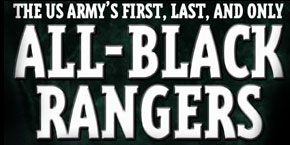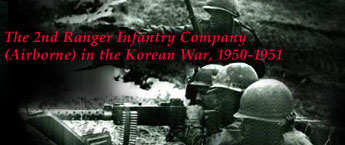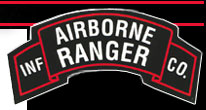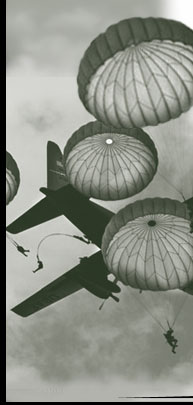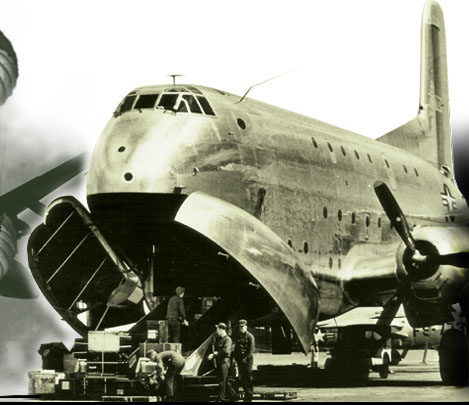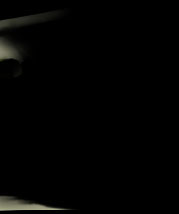9 December 1947 |
The 555th Parachute Infantry Company was inactivated and its colors folded. Its new designation was the 3rd Battalion, 505th Parachute Infantry Regiment, 82nd Airborne Division. This was the Army's first integration of a black unit into an all white unit. |
26 July 1948 |
President Harry S. Truman passed Executive Order 9981 dated 26 July 1948, which officially desegregated the U.S. military. |
25 June 1950 |
North Korean Army crossed the 38th parallel and invaded South Korea thus the Korean Conflict erupted. The 38th parallel separated North and South Korea. |
November 1950 |
1st, 2nd, 3rd and 4th Company were activated and
assigned to the Ranger Training Center. Members of the
2nd Rangers were recruited, trained, and prepared for
deployment to Korea, September through December 1950. |
November 1950 |
2nd Ranger Infantry Company (Airborne) was activated at Fort Benning, Georgia. Personnel were taken from the 3rd Battalion, (a parent unit), 505th Airborne Infantry Regiment and the 80th Anti-aircraft Artillery Battalion of the 82nd Airborne Division. The parent organization of this unit was Company A, 2nd Ranger Battalion, which was inactivated after World War II. Characterized as the "best of the elite" unit, the 2nd Ranger Company was the first, last, and only all-black Ranger unit in the history of the United States Army. The Company's first commander was 1st Lieutenant Warren E. Allen of the Los Angeles, CA. The Company received rigorous training at the Ranger Training Center at Fort Benning, Georgia. |
November 1950 |
The 2nd Rangers were sent to Fort Benning, Georgia, for Special advanced training. The change of designation of 4th Company to 2nd Company occurred in November 1950 when the Department of the Army changed all units from Army Special Unit (ASU) to Table of Organization and Equipment (TO&E) units (part of the Regular Army). |
3 December 1950 |
2nd Ranger Company departed Fort Benning, Georgia by train for Camp Stoneman in California. At that time, the 2nd Ranger Company had 5 officers and 116 enlisted men along with the 4th Rangers who had 4 officers and 118 enlisted men. |
9 December 1950 |
2nd Ranger Company left San Francisco, California aboard the USS General H.W. Butner, stopped at Pearl Harbor en route to Korea. |
23 December 1950 |
2nd Ranger Infantry Company met African American women serving in the U.S. Women's Army Corps aboard the USS General H.W. Butner to Korea, December 1950 en route to Yokohoma Engineer Depot, Yokohoma, Japan. |
24 December 1950 |
2nd Rangers left Honolulu, Hawaii and sailed to Yokohama, Japan arriving on Christmas Eve. The Company entrained at shipside for movement to Camp Zama, Japan, where they were shipped to Korea. |
30 December 1950 |
The 2nd Ranger Company was airlifted from Tachikawa Air Force Base, Japan, to Taegu Air Force Base, Korea. The unit was assigned to the Eighth United States Army and attached to the 7th Infantry Division. |
31 December 1950 |
The 2nd Ranger Company closed into the 7th Division area New Year's Eve. The 2nd Rangers were deployed to Korea at a critical time at war - the United Nations faced staggering odds. |
5 January 1951 |
2nd Rangers arrived in Wonju via Tanyang with mission of blocking enemy threats from the northeast. They traveled 103 miles from Yongchon to Changnim-ni via Andong. |
7 January 1951 |
2nd Ranger Company's first combat action in Korea began outside Tangyang Pass. 2nd Ranger Company arrived in Korea during the CCF Intervention, that had been in progress since 3 November. The 2nd Ranger Company were assigned to protect an important rail line running through Central Korea at a place call Tanyang Pass. This rail line allowed essential supplies to travel to the units further north, fighting to halt the Chinese Communist forces that were attempting to push UN forces off the peninsula and bring South Korea under Communist domination. 2nd Ranger SFC Isaac Baker was killed and Rangers Webb Paulding and Wheeler Small were wounded. |
14 January 1951 |
2nd Ranger Company entered the village of Majori-ri with the mission of taking possession of the village and then continuing the assault with another unit. They drove the enemy from the town, but the Chinese ambushed the other American Forces in a mountain counterattack. Eight 2nd Rangers were killed and ten were wounded. |
21 January 1951 |
2nd Rangers established headquarters in Tanyang. Their mission was to search out enemy guerrillas. |
20 February 1951 |
2nd Ranger Company captured Chuchon, 8 miles to the northeast. Received recognition for their attack in the International New Service "banzai". |
22 February 1951 |
2nd Rangers attached to the 187th Airborne Regimental Combat Team (RCT). |
28 February 1951 |
2nd and 4th Rangers were en route to be attached to the 187th Airborne RCT. Ground linkup was the Task Force Growden including the 6th Medium Tank Battalion, Infantry, and Artillery. Their mission was to attack from Seoul to Munsan-ni. The 2nd and 4th Ranger Companies would be a part of the second serial to jump on Drop Zone (DZ) North, proceeded by the 3rd Battalion of the 187th. |
23 March 1951 |
2nd Ranger Company participate in the First UN Counteroffensive (with arrowhead) for airborne assault landing with the 187th Airborne Regimental Combat Team at Munsan-ni, Korea, on 23 March 1951. The 2nd Rangers achieved their objectives the day of the air assault, while suffering relatively light casualties. Commanded by Captain Warren E. Allen, the 2nd Ranger Company became the first United States all-Black unit to make a parachute jump behind enemy lines with the 187th Airborne Regimental Combat Team aboard C-46 airplanes at Munsan-ni, Korea. The 2nd Rangers move through enemy gun fire, high terrain, killing many Communists, and captured 20 prisoners. The unit was awarded the Bronze Arrowhead for Parachute Assault at Munsan-ni and its service in this engagement. The dangerous and historic action at Musan-ni was the extent of 2nd Ranger participation in combat operations during the First UN Counteroffensive. |
March 1951 |
2nd Ranger Company participate in the assault on Hill 151. Their mission was to seize the hill a key terrain in the zone of the 2nd Battalion, 187th Airborne RT. The attack was supported by F-51 fighters and 81 mm mortar fire by the Company's executive officer then LT James C. Queen. During this attack, one Ranger was killed, PFC William Van Dunk, 2 wounded: SFC Boatwright and Sgt. Robertson. |
4 April 1951 |
2nd and 4th Rangers received new assignments. 2nd Rangers were to become a training base for black soldiers assigned to the 7th Infantry Division. Their mission was to provide two weeks of training to 52 replacements. |
21 April 1951 |
The First UN Counteroffensive ended. The 2nd Rangers spent the remainder of the campaign undergoing a period of training and reinforcement in the vicinity of Hangyee. |
22 April 1951 |
2nd Rangers participate in the CCF Spring Offensive, which began on 22 April 1951. |
29 April 1951 |
2nd Rangers were ordered to move a few miles northwest to occupy and hold a hill outside of village of Chaun-ni. Later during the campaign, on 19 and 20 May, the 2 d Rangers participated in the assault on Hill 581. |
30 April 1951 |
2nd Rangers had 125 men assigned and 282 attached. Also, 2nd Rangers were performing combat patrols with the 3 rd Regiment, 7th ROK Division. |
20-21 May 1951 |
2nd Rangers lead assault on Hill 581 killing 50 Chinese and wounding 90 in about 2 hours. 17 members of the 2nd Rangers were awarded the Purple Heart , and 7 were cited for bravery. |
1 June 1951 |
2nd Ranger Company occupied a position in the KANSAS Line in the vicinity of the Hwachon Reservoir. |
11 June 1951 |
2nd Ranger Company occupied a position in the KANSAS Line in the vicinity of the Hwachon Reservoir. |
8 July 1951 |
2nd Ranger Company assaulted and occupied Hill 545 in the vicinity of Yonochanga. This engagement was the last one during the CCF Spring Offensive the Rangers would participate in before its conclusion. |
9 July - 27 |
2nd Ranger Company confront the last enemy engagement during the Korean War. |
November 1952 |
The UN Summer - Fall Offensive in progress. 2nd Ranger Company was held in reserve, its personnel were gradually reassigned. 1st, 2nd, 3rd, 4th, 5th, and 8th Ranger Companies were to be inactivated by the commanding generals of the divisions to which the rangers were attached. |
1 August 1951 |
2nd Ranger Infantry Company (Airborne) unit was officially inactivated. |
